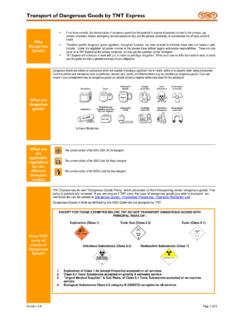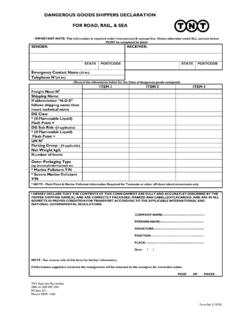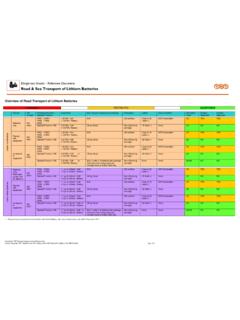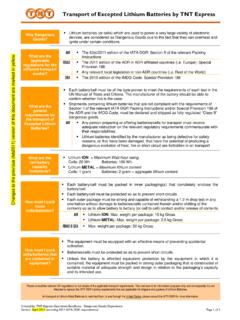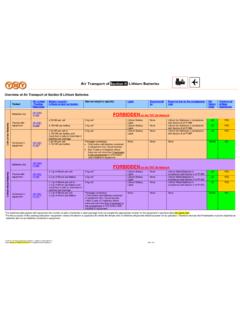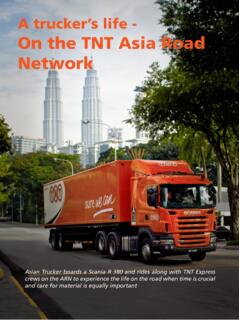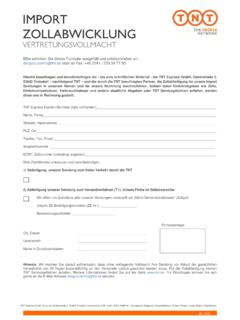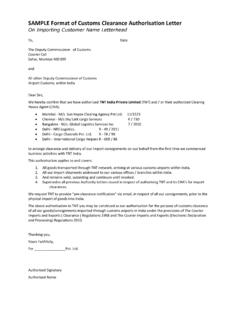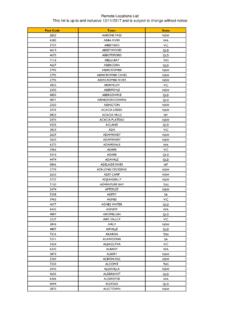Transcription of Dangerous Goods Reference Document Road & Sea …
1 Dangerous Goods Reference Document Road & Sea transport of Lithium Batteries Created by: TNT express Dangerous Goods Department Version: December 2017 (based on the 2017 edition of the ADR & the 2015 edition of the IMDG Code) Page 1 of 5 Overview of Road transport of Lithium Batteries FORBIDDEN RESTRICTED ACCEPTABLE Packed UN number Packing Instruction / Special Provision Limitations Max weight or quantity per package Packaging Labels Documentation DG Option Code Shipper Approved Country Approved Lithium Ion Batteries Batteries only UN 3480 P903 LP903 P908 LP904 P909 > 20 Wh / Cell > 100 Wh / Battery N/A UN certified Class 9 LB Label (1)
2 ADR Declaration HZ YES YES Special Provision 188 20 Wh / Cell 100 Wh / Battery 30 kg Gross Non UN strong and rigid LB Mark (1) None LB NO NO Packed with equipment UN 3481 P903 LP903 P908 LP904 P909 > 20 Wh / Cell > 100 Wh / Battery N/A UN certified Class 9 LB Label (1) ADR Declaration HZ YES YES Special Provision 188 20 Wh / Cell 100 Wh / Battery 30 kg Gross Non UN strong and rigid LB Mark (1) None LB NO NO Contained in equipment UN 3481 P903 LP903 P908 LP904 P909 > 20 Wh / Cell > 100 Wh / Battery N/A UN certified Class 9 LB Label (1) ADR Declaration HZ YES YES Special Provision 188 20 Wh / Cell or 100 Wh / Battery 30 kg Gross Non UN strong and rigid LB Mark (1) None LB NO NO Special Provision 188 20 Wh / Cell or 100 Wh / Battery Max 4 cells or 2 batteries per package (not more then 2 packages per consignment)
3 Or button cells only Non UN strong and rigid None None NONE NO NO Lithium Metal Batteries Batteries Only Restricted on the TNT Air Network UN 3090 P903 LP903 P908 LP904 P909 > 1 gr of Lithium / Cell > 2 gr of Lithium / Battery N/A UN certified Class 9 LB Label (1) ADR Declaration HZ YES YES Special Provision 188 1 gr of Lithium / Cell 2 gr of Lithium / Battery 30 kg Gross Non UN strong and rigid LB Mark (1) None LB NO NO Packed with equipment UN 3091 P903 LP903 P908 LP904 P909 > 1 gr of Lithium / Cell > 2 gr of Lithium / Battery N/A UN certified Class 9 LB Label (1) ADR Declaration HZ YES YES Special Provision 188 1 gr of Lithium / Cell 2 gr of Lithium / Battery 30 kg Gross Non UN strong and rigid LB Mark (1) None LB NO NO Contained in equipment UN 3091 P903 LP903 P908 LP904 P909 > 1 gr of Lithium / Cell > 2 gr of Lithium / Battery N/A UN certified Class 9 LB Label (1)
4 ADR Declaration HZ YES YES Special Provision 188 1 gr of Lithium / Cell or 2 gr of Lithium / Battery 30 kg Gross Non UN strong and rigid LB Mark (1) None LB NO NO Special Provision 188 1 gr of Lithium / Cell or 2 gr of Lithium / Battery Max 4 cells or 2 batteries per package (not more then 2 packages per consignment) or button cells only Non UN strong and rigid None None NONE NO NO 1 The previous provisions for the Class 9 label and Lithium Battery Label may continue to be used until 31 December 2017 Dangerous Goods Reference Document Road & Sea transport of Lithium Batteries Created by: TNT express Dangerous Goods Department Version: December 2017 (based on the 2017 edition of the ADR & the 2015 edition of the IMDG Code) Page 2 of 4 Scope: This Document covers Road transport in ADR affiliated countries ( mainly Europe) as well as global Sea transport 1.
5 Introduction Lithium batteries are considered as hazardous Goods due to the fact that they can overheat and ignite under certain conditions. For specific information on Air transport , please consult the relevant TNT Reference Document or the applicable regulations. 2. Definitions, Classification & Identification The term lithium battery refers to a family of batteries with different chemistries, comprising many types of cathodes and electrolytes. They are separated into: LITHIUM ION BATTERIES (sometimes abbreviated Li-ion batteries) Rechargeable batteries commonly used in consumer electronics.
6 Also included within lithium-ion batteries are lithium polymer batteries. Generally used in consumer electronics such as laptops, mobile phones, MP3 players, portable DVD players, calculators, GPS/navigation systems, cameras, camcorders, diving lamps, etc. In the ADR and IMDG Code, Lithium Ion Batteries (including lithium polymer batteries) are classified/listed as follows: UN Number Proper Shipping Name Class UN3480 Lithium ion batteries 9 UN3481 Lithium ion batteries packed with equipment or Lithium ion batteries contained in equipment 9 LITHIUM METAL BATTERIES Non-rechargeable/disposable batteries that have lithium metal or lithium compounds as an anode.
7 Also included within lithium metal batteries are lithium alloy batteries. Generally used in small, portable electronic devices, such as, watches, thermometers, calculators, remote car locks, backup batteries in computers and communication equipment, etc. In the ADR and IMDG Code, Lithium Metal Batteries are classified/listed as follows: UN Number Proper Shipping Name Class UN3090 Lithium metal batteries 9 UN3091 Lithium metal batteries packed with equipment or Lithium metal batteries contained in equipment 9 Dangerous Goods Reference Document Road & Sea transport of Lithium Batteries Created by: TNT express Dangerous Goods Department Version: December 2017 (based on the 2017 edition of the ADR & the 2015 edition of the IMDG Code) Page 3 of 4 3.
8 transport of Lithium Batteries as per ADR Special Provision 188 Shipments of lithium batteries that are compliant with Special Provision 188 of the ADR/IMDG Regulations are not subject to other provisions of the applicable regulations and can therefore be transported as Excepted Lithium Batteries. ADR / IMDG Code Special Provision 188 Requirement Overview General: Each cell or battery must be of the type proven to meet the requirements of each test in the UN Manual of Tests and Criteria, Part III, subsection (the manufacturer of the battery should be able to confirm whether this is the case) Cell/Battery Capacity Limitations: Lithium ION (UN3480 & UN3481) Lithium METAL (UN3090 & UN3091) Maximum Watt-hour rating: Cells: 20 Wh Batteries.
9 100 Wh The Watt-hour (Wh) rating must be marked on the outside of the battery case except for batteries manufactured before 1 January 2009 which may be transported without this marking until 31 December 2010 Maximum Lithium Content Cells: 1 gram Batteries: 2 gram* * = aggregate lithium content Packaging of loose cells or batteries: Each cell or battery must be packed in inner packaging(s) that completely enclose the cell or battery. Each cell or battery must be protected so as to prevent short circuits (including protection against contact with conductive materials within the same packaging that could lead to a short circuit) Each inner package must be packed in a strong outer packaging that is conforming to and Each package must be capable of withstanding a m drop test in any orientation without.
10 Damage to cells or batteries contained therein shifting of the contents so as to allow battery to battery (or cell to cell) contact release of contents Maximum gross weight per package: kg Gross Packaging of cells or batteries that are installed in equipment: Each cell or battery must be protected from damage and short circuit The equipment shall be equipped with an effective means of preventing accidental activation The equipment shall be packed in strong outer packaging constructed of suitable material of adequate strength and design in relation to the packaging s capacity and its intended use unless the battery is afforded equivalent protection by the equipment in which it is contained Marking: not applicable for.
